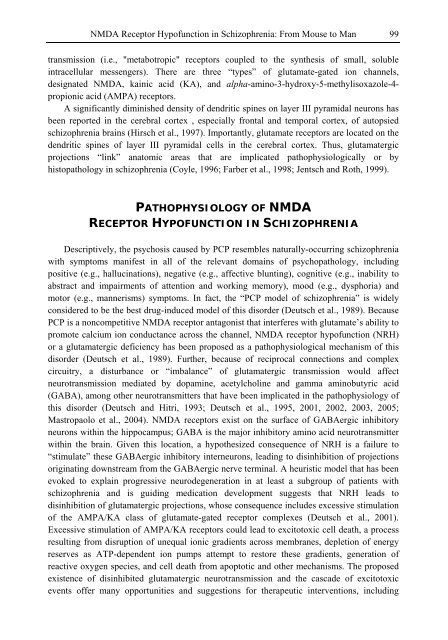Schizophrenia Research Trends
Schizophrenia Research Trends
Schizophrenia Research Trends
- No tags were found...
Create successful ePaper yourself
Turn your PDF publications into a flip-book with our unique Google optimized e-Paper software.
NMDA Receptor Hypofunction in <strong>Schizophrenia</strong>: From Mouse to Man 99transmission (i.e., "metabotropic" receptors coupled to the synthesis of small, solubleintracellular messengers). There are three “types” of glutamate-gated ion channels,designated NMDA, kainic acid (KA), and alpha-amino-3-hydroxy-5-methylisoxazole-4-propionic acid (AMPA) receptors.A significantly diminished density of dendritic spines on layer III pyramidal neurons hasbeen reported in the cerebral cortex , especially frontal and temporal cortex, of autopsiedschizophrenia brains (Hirsch et al., 1997). Importantly, glutamate receptors are located on thedendritic spines of layer III pyramidal cells in the cerebral cortex. Thus, glutamatergicprojections “link” anatomic areas that are implicated pathophysiologically or byhistopathology in schizophrenia (Coyle, 1996; Farber et al., 1998; Jentsch and Roth, 1999).PATHOPHYSIOLOGY OF NMDARECEPTOR HYPOFUNCTION IN SCHIZOPHRENIADescriptively, the psychosis caused by PCP resembles naturally-occurring schizophreniawith symptoms manifest in all of the relevant domains of psychopathology, includingpositive (e.g., hallucinations), negative (e.g., affective blunting), cognitive (e.g., inability toabstract and impairments of attention and working memory), mood (e.g., dysphoria) andmotor (e.g., mannerisms) symptoms. In fact, the “PCP model of schizophrenia” is widelyconsidered to be the best drug-induced model of this disorder (Deutsch et al., 1989). BecausePCP is a noncompetitive NMDA receptor antagonist that interferes with glutamate’s ability topromote calcium ion conductance across the channel, NMDA receptor hypofunction (NRH)or a glutamatergic deficiency has been proposed as a pathophysiological mechanism of thisdisorder (Deutsch et al., 1989). Further, because of reciprocal connections and complexcircuitry, a disturbance or “imbalance” of glutamatergic transmission would affectneurotransmission mediated by dopamine, acetylcholine and gamma aminobutyric acid(GABA), among other neurotransmitters that have been implicated in the pathophysiology ofthis disorder (Deutsch and Hitri, 1993; Deutsch et al., 1995, 2001, 2002, 2003, 2005;Mastropaolo et al., 2004). NMDA receptors exist on the surface of GABAergic inhibitoryneurons within the hippocampus; GABA is the major inhibitory amino acid neurotransmitterwithin the brain. Given this location, a hypothesized consequence of NRH is a failure to“stimulate” these GABAergic inhibitory interneurons, leading to disinhibition of projectionsoriginating downstream from the GABAergic nerve terminal. A heuristic model that has beenevoked to explain progressive neurodegeneration in at least a subgroup of patients withschizophrenia and is guiding medication development suggests that NRH leads todisinhibition of glutamatergic projections, whose consequence includes excessive stimulationof the AMPA/KA class of glutamate-gated receptor complexes (Deutsch et al., 2001).Excessive stimulation of AMPA/KA receptors could lead to excitotoxic cell death, a processresulting from disruption of unequal ionic gradients across membranes, depletion of energyreserves as ATP-dependent ion pumps attempt to restore these gradients, generation ofreactive oxygen species, and cell death from apoptotic and other mechanisms. The proposedexistence of disinhibited glutamatergic neurotransmission and the cascade of excitotoxicevents offer many opportunities and suggestions for therapeutic interventions, including
















